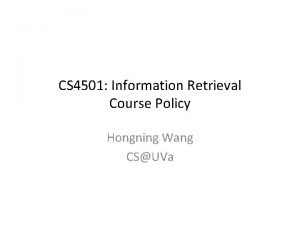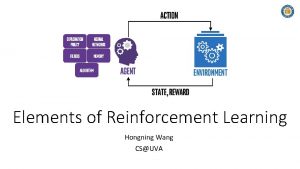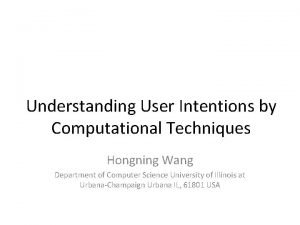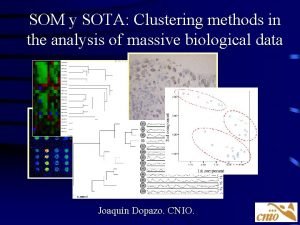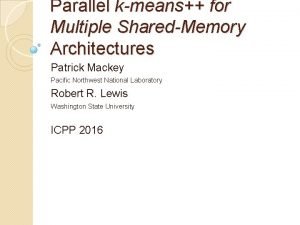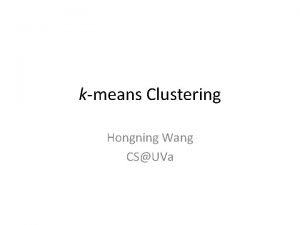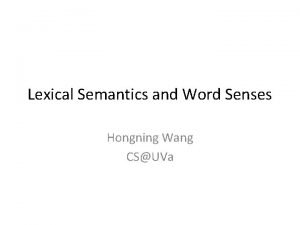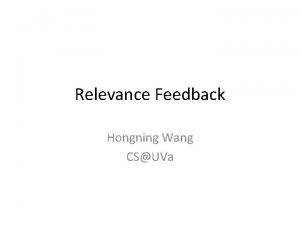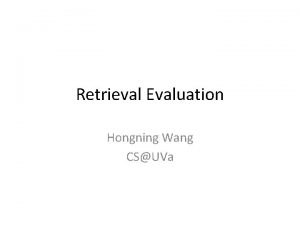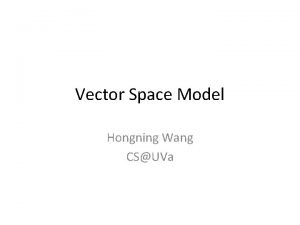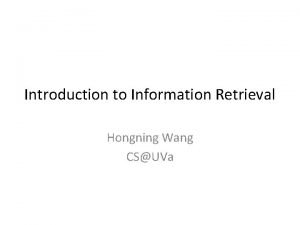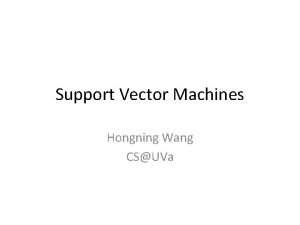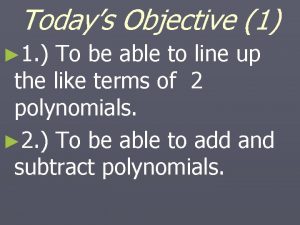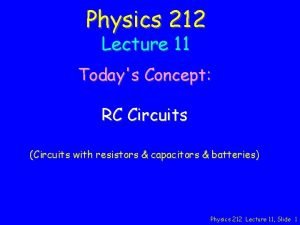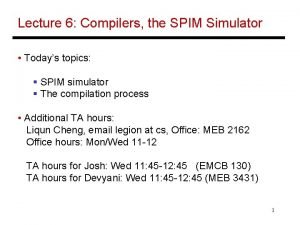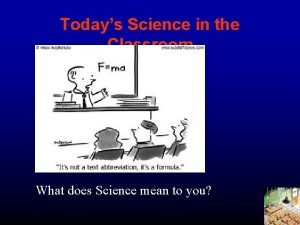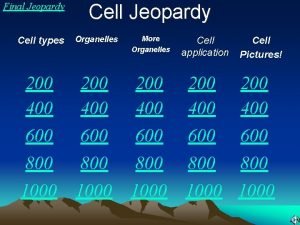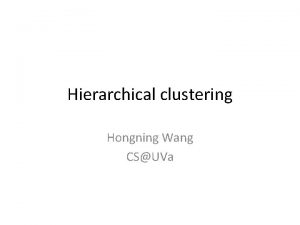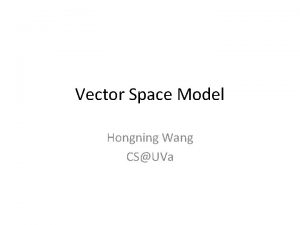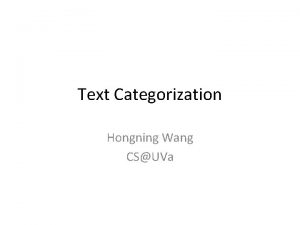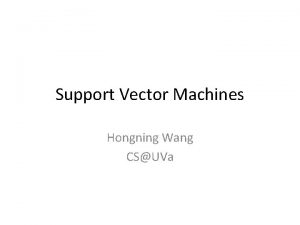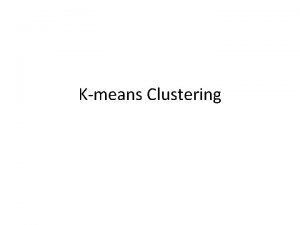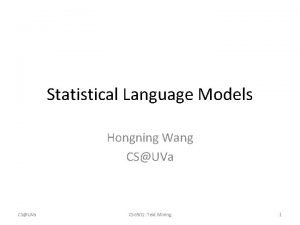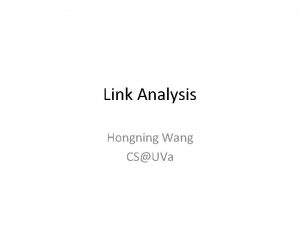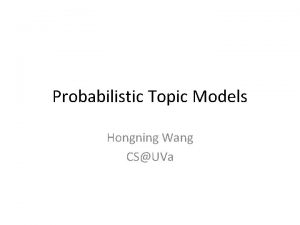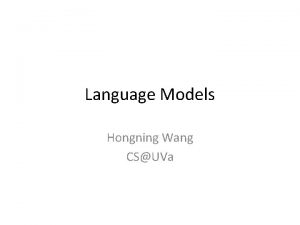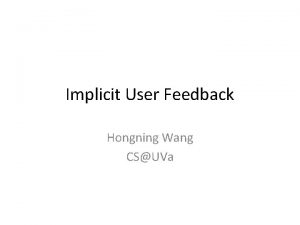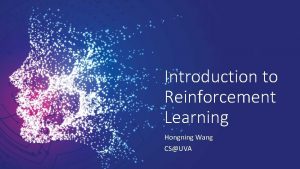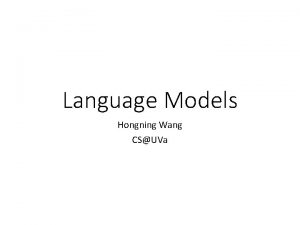kmeans Clustering Hongning Wang CSUVa Todays lecture kmeans



































- Slides: 35

k-means Clustering Hongning Wang CS@UVa

Today’s lecture • k-means clustering – A typical partitional clustering algorithm – Convergence property • Expectation Maximization algorithm – Gaussian mixture model CS@UVa CS 6501: Text Mining 2

Partitional clustering algorithms • Partition instances into exactly k nonoverlapping clusters – Flat structure clustering – Users need to specify the cluster size k – Task: identify the partition of k clusters that optimize the chosen partition criterion CS@UVa CS 6501: Text Mining 3

Partitional clustering algorithms • Optimize this in an alternative way Inter-cluster distance Intra-cluster distance Let’s approximate this! CS@UVa Unfortunately, this is NP-hard! CS 6501: Text Mining 4

k-means algorithm • Minimize intra distance Maximize inter distance CS@UVa CS 6501: Text Mining 5

k-means illustration CS@UVa CS 6501: Text Mining 6

k-means illustration Voronoi diagram CS@UVa CS 6501: Text Mining 7

k-means illustration CS@UVa CS 6501: Text Mining 8

k-means illustration CS@UVa CS 6501: Text Mining 9

k-means illustration CS@UVa CS 6501: Text Mining 10

Complexity analysis • CS@UVa CS 6501: Text Mining 11

Convergence property • Why will k-means stop? – Answer: it is a special version of Expectation Maximization (EM) algorithm, and EM is guaranteed to converge – However, it is only guaranteed to converge to local optimal, since k-means (EM) is a greedy algorithm CS@UVa CS 6501: Text Mining 12

Probabilistic interpretation of clustering • Mixture model Unimodal distribution Mixing proportion CS@UVa CS 6501: Text Mining 13

Probabilistic interpretation of clustering • Mixture model Unimodal distribution Mixing proportion CS@UVa CS 6501: Text Mining 14

Probabilistic interpretation of clustering Usually a constrained optimization problem • Mixture model Unimodal distribution Mixing proportion CS@UVa CS 6501: Text Mining 15

Introduction to EM • E. g. cluster membership Most of cases are intractable CS@UVa CS 6501: Text Mining 16

Background knowledge • CS@UVa CS 6501: Text Mining 17

Expectation Maximization • Jensen's inequality Lower bound: easier to compute, many good properties! CS@UVa CS 6501: Text Mining 18

Intuitive understanding of EM Data likelihood p(X| ) Easier to optimize, guarantee to improve data likelihood Lower bound CS@UVa CS 6501: Text Mining 19

Expectation Maximization (cont) • CS@UVa CS 6501: Text Mining 20

Expectation Maximization (cont) • CS@UVa CS 6501: Text Mining 21

Expectation Maximization (cont) • CS@UVa CS 6501: Text Mining 22

Expectation Maximization (cont) • Expectation of complete data likelihood CS@UVa CS 6501: Text Mining 23

Expectation Maximization • Key step! CS@UVa CS 6501: Text Mining 24

Intuitive understanding of EM Data likelihood p(X| ) next guess current guess Lower bound (Q function) E-step = computing the lower bound M-step = maximizing the lower bound CS@UVa CS 6501: Text Mining 25

Convergence guarantee • Proof of EM Cross-entropy Then the change of log data likelihood between EM iteration is: M-step guarantee this CS@UVa CS 6501: Text Mining 26

What is not guaranteed • CS@UVa CS 6501: Text Mining 27

k-means v. s. Gaussian Mixture • Multinomial In k-means, we assume equal variance across clusters, so we don’t need to estimate them We do not consider cluster size in k-means CS@UVa CS 6501: Text Mining 28

k-means v. s. Gaussian Mixture • Soft v. s. , hard posterior assignment GMM CS@UVa k-means CS 6501: Text Mining 29

k-means in practice • Extremely fast and scalable – One of the most popularly used clustering methods • Top 10 data mining algorithms – ICDM 2006 – Can be easily parallelized • Map-Reduce implementation – Mapper: assign each instance to its closest centroid – Reducer: update centroid based on the cluster membership – Sensitive to initialization • Prone to local optimal CS@UVa CS 6501: Text Mining 30

Better initialization: k-means++ • new center should be far away from existing centers CS@UVa CS 6501: Text Mining 31

How to determine k • CS@UVa CS 6501: Text Mining 32

How to determine k • CS@UVa CS 6501: Text Mining 33

What you should know • k-means algorithm – An alternative greedy algorithm – Convergence guarantee • EM algorithm – Hard clustering v. s. , soft clustering • k-means v. s. , GMM CS@UVa CS 6501: Text Mining 34

Today’s reading • Introduction to Information Retrieval – Chapter 16: Flat clustering • 16. 4 k-means • 16. 5 Model-based clustering CS@UVa CS 6501: Text Mining 35
 Hongning wang
Hongning wang Hongning wang
Hongning wang Hongning wang
Hongning wang Hongning wang
Hongning wang Hongning wang
Hongning wang Euclidean distance rumus
Euclidean distance rumus Flat clustering
Flat clustering L
L Sota analysis
Sota analysis Javascript kmeans
Javascript kmeans Thrust kmeans
Thrust kmeans Csuva
Csuva Csuva
Csuva Csuva
Csuva Csuva
Csuva Vector space modeling
Vector space modeling Csuva
Csuva Csuva
Csuva Csuva
Csuva Csuva
Csuva 01:640:244 lecture notes - lecture 15: plat, idah, farad
01:640:244 lecture notes - lecture 15: plat, idah, farad Todays jeopardy
Todays jeopardy Handcuffing techniques lesson plan
Handcuffing techniques lesson plan Date frui
Date frui Todays objective
Todays objective Todays concept
Todays concept Todays globl
Todays globl Todays science
Todays science Todays goal
Todays goal Safe online talk
Safe online talk Today planets position
Today planets position Cells jeopardy 7th grade
Cells jeopardy 7th grade Todays health
Todays health Todays class com
Todays class com Multiple choice comma quiz
Multiple choice comma quiz Teacher good morning everyone
Teacher good morning everyone
